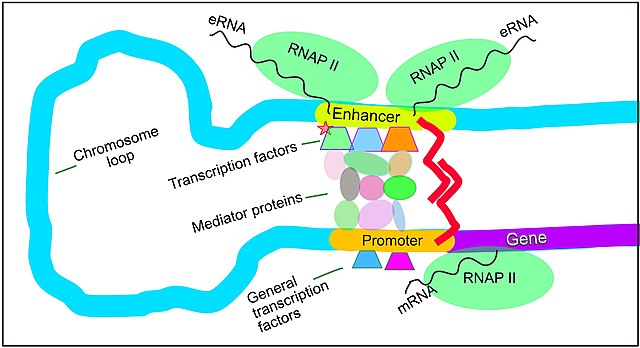A coactivator is a type of transcriptional coregulator that binds to an activator to increase the rate of transcription of a gene or set of genes. The activator contains a DNA binding domain that binds either to a DNA promoter site or a specific DNA regulatory sequence called an enhancer. Binding of the activator-coactivator complex increases the speed of transcription by recruiting general transcription machinery to the promoter, therefore increasing gene expression. The use of activators and coactivators allows for highly specific expression of certain genes depending on cell type and developmental stage.
Histone acetyltransferase (HAT) removes the acetyl group from acetyl-CoA and transfers it the N-terminal tail of chromatin histones. In the reverse reaction, histone deacetylase (HDAC) removes the acetyl group from the histone tails and binds it to coenzyme A to form acetyl-CoA.
Transcription is the process of copying a segment of DNA into RNA. The segments of DNA transcribed into RNA molecules that can encode proteins produce messenger RNA (mRNA). Other segments of DNA are transcribed into RNA molecules called non-coding RNAs (ncRNAs).
Regulation of transcription in mammals. An active enhancer regulatory region of DNA is enabled to interact with the promoter DNA region of its target gene by the formation of a chromosome loop. This can initiate messenger RNA (mRNA) synthesis by RNA polymerase II (RNAP II) bound to the promoter at the transcription start site of the gene. The loop is stabilized by one architectural protein anchored to the enhancer and one anchored to the promoter and these proteins are joined to form a dimer (red zigzags). Specific regulatory
Electron micrograph of transcription of ribosomal RNA. The forming ribosomal RNA strands are visible as branches from the main DNA strand.[citation needed]
Scheme of reverse transcription




